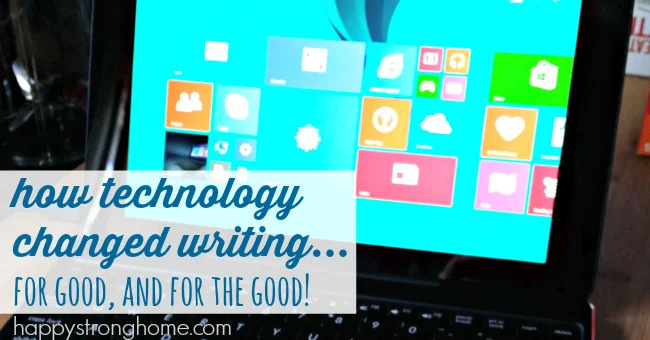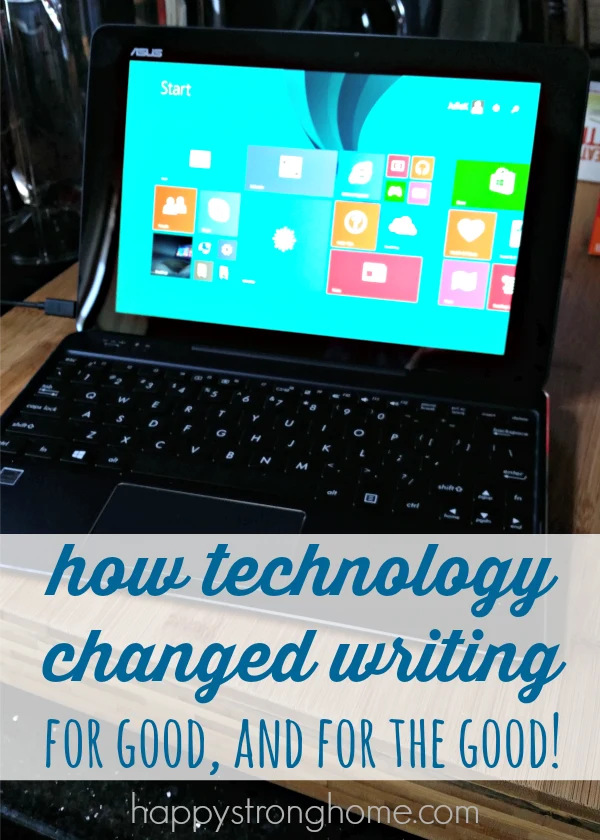My first writing notebook was a purple spiral bound with stickers randomly scattered over the cover. Inside, my loopy cursive penned poems onto the pages. Just a few. Then the pages are blank.
Later, I would filled folders with loose-leaf sheets oozing with romantic “novels” that never saw an end.
And then… I got my first laptop. It was a graduation gift in 1994. And if you remember 1994, you might recall most people weren’t getting laptops to go off to college! But I’ve always been a bit of a tech-geek (and so has my dad, I think!), so a laptop was my graduation gift of choice!
I still kept a diary in bound journals. But I rapidly shifted to drafting, editing and revising my writing on-screen, and printing out satisfyingly perfect copies [dot matrix: peels off side strips].
It didn’t take long to convince me that technology would change writing… for good, and for the good (mostly!).

Here’s just a few important ways technology has changed writing:
- Removes the tedium and time of handwriting long pieces (see: benefits of a digital writer’s notebook!)
- Reduces paper clutter (caveat: back up your work!)
- Allows for easier organizing and finishing of projects (but… you still have to DO the work yourself! As far as I know!)
- Provides instant access to resources like thesaurus, dictionary, and even source materials!
- Allows the author to write, edit, and revise nearly simultaneously (I do think somewhat is lost here, but overall, it’s a huge time saver!)
- Removes impediments to certain editing tasks (can be especially important for young writers with learning or physical challenges to writing)
- Allows for speedy sharing between writers and editors
- Gives multiple platforms for publishing work (blog, microblogs (Facebook, Twitter, Instagram), news platforms, self-publishing)
- Allows for nearly instant feedback from readers / fans (the excitement of blog comments, likes, and shares!)
- Allows fans to share an author’s work exponentially (I mean, really, like NEVER before!)
Most of the above, if not all, can be counted as positive change for writing. Generally, the writing process itself hasn’t changed. Writers still generate ideas, nurture ideas, draft, revise, edit, and publish. It’s just a much faster process, and somewhat easier, overall!
All those benefits aside, there IS something to be said for the old pen-to-paper way of writing. Just as there’s a strong case for the paper book over the e-book. But the beauty is, we can easily have both now!
As technology progresses, I often wonder what writing will be like for my boys (we’ll be sticking with the paper version for these early years).
And now, for a revising tip that may not have been feasible before technology.
I call it “front of the line” revision. It’s really an exercise in sentence variety. And one that would’ve been tedious to do by hand.
Today I want to show you how to improve sentence variety
by checking the front, or beginning, of each sentence
to be sure you include a variety of sentence openers.
To start, take a paragraph or piece of writing. Presumably, you have already typed it out? Good.
Now, after each sentence, hit the return key. This will place each and every sentence on an individual line! That’s what you want. Then I want you to look closely at the “front of the line.” What do you notice about the beginnings of each sentence as you read?
I’m only giving you a snippet here, but poor sentence variety might show up more in a longer piece.
Here’s a sample paragraph (from a mock version of my post A Tale of Two Lion Loveys):
He showed me the little stuffed lion and said, “Mommy, this lovey has boo-boo!” He looked sadly at the toy. He pointed to the stuffed toy’s head, and indeed on closer inspection, a stitch mark turned out to be a little hole in the terry fabric.
Separated sentences:
He showed me the little stuffed lion and said, “Mommy, this lovey has boo-boo!”
He looked sadly at the toy.
He pointed to the stuffed toy’s head, and indeed on closer inspection, a stitch mark turned out to be a little hole in the terry fabric.
Notice anything? Exactly! All my sentences start with “he.” Well. That’s boring! Doing this little exercise pointed out my need for greater sentence variety! Time to get revising!
Revised paragraph (and my sentence revision led me to add more details! Added bonus!):
“Mommy, this lovey has boo-boo!” my two year old said, concern edging his voice.
The five-year old stopped bouncing on my bed long enough to snag his worn lion lovey back into his arms. I yawned and said, “No, honey, it’s just been loved so much.”
But he couldn’t let it go, “See, here, boo-boo!” He pointed to the stuffed toy’s head, and indeed, on closer inspection, what looked like a stitch mark was really a little hole in the terry fabric of the lion lovey’s forehead.
You fix your sentences, and then you remove the line breaks, so you have paragraphs again. Easy as that!
But… how hard would that have been without technology? Right!?
Since my first little laptop over twenty years ago, I’ve been through a variety of machines. Each one making my job as a writer easier and easier (except the actual butt-in-chair part!). The best part is that portable devices just keep getting better and better. As a writer, here’s what I love about my latest writing machine: the ASUS Transformer Book T100 Chi:
- Conversion from tablet to laptop gives me greater portability! And takes about 1 second!
- Writer-friendly software like Microsoft OneNote is preinstalled!
- Long battery life means… I can write to my heart’s content during my entire six hour plane ride to Seattle (coming up!).
- And it’s so thin, packing it won’t take much space!
Where would writers be without their technology these days, I wonder? I know I could never go back to handwriting everything again!
What’s the biggest way technology has changed writing for you? Or your particular line of work?


#spon: I’m required to disclose a relationship between our site and Intel This could include Intel providing us w/content, product, access or other forms of payment.

